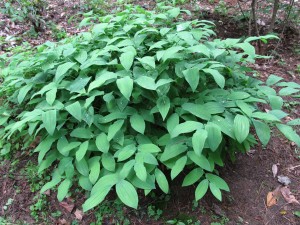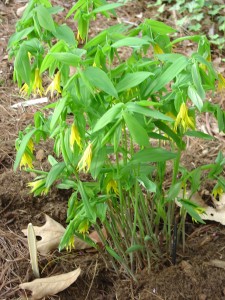The soft yellow bell-shaped flowers of bellworts (Uvularia spp.), aka merrybells, contribute to spring’s awakening in U.S. woodlands and shade gardens (USDA hardiness zones 3-9). On both U. grandiflora and U. perfoliata, flower stems pierce (pass through) the center of the leaves. A third species, (U. sessilifolia), nicknamed Wild Oats, grows in northern woodlands; leaves of latter are sessile (without a peduncle) and are not pierced by floral stem.
All are U.S. natives and bloom in April, May or June depending on regional location. Bellworts are members of the Liliaceae family, and are among the easiest of wildflowers to grow. Their nodding bell-shaped flowers are a springtime delight. Bellworts appear delicate looking, but are hardy and enduring. Over the years individual clumps colonize among themselves from thick fleshy white underground stolons.
Bellwort leaves are elliptic, glaucous (blue-green), and entire on 6-18 inch tall plants. Each solitary flower is just over an inch long composed of six soft yellow tepals (three petals and three sepals). Fruits (three-angled seed pods) form in the fall.
Plant bellworts in partial to full shade in compost-rich, moist, well-drained woodsy soil. Leaves turn clear yellow in early fall; it’s not unusual to observe some leaf burn on edges after a dry summer. Bellworts tolerate dry calcareous (limestone) sites after settling in for 2 years. No insect or disease problems are rare, but young emerging shoots may be damaged by slugs.
“Wort” is a name formerly given to plants used for food or medicine. Bellwort was sometimes used to cure throat problems.



 Posted in
Posted in 
